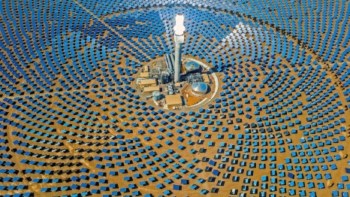
- This story is part of Covering Climate Now, a global collaboration of more than 250 news outlets to strengthen coverage of the climate story.
With the reality of climate change looming, the importance of realistic green energy sources is higher than ever. Solar cells are one promising avenue, as they can convert readily available visible and ultraviolet energy into usable electricity. In particular, perovskite materials sandwiched between other support layers have demonstrated impressive power conversion efficiencies. Current challenges reside in optimizing perovskite/support layer interfaces, which can directly impact power conversion and cell degradation. Researchers Antonio Agresti et al. under the direction of Aldo Di Carlo at the University of Rome Tor Vergata in Italy have investigated how cells containing two-dimensional titanium-carbide MXene support layers could improve perovskite solar cell performance.
Tuned MXenes as buffer layers
To obtain good power conversion within a perovskite solar cell, all layers and layer interfaces within the cell must have good compatibility. Typical cells contain the active perovskite material sandwiched between two charge transport layers, which are then adjacent to their corresponding electrodes. Support layers may also be added. Charge mobility, energy barriers, interface energy alignment, and interfacial vacancies all impact compatibility and subsequent cell performance and stability. Thus, engineering well-suited interfaces with the cell is paramount to cell success and long-term stability, an important criterion for potential commercialization.
Two-dimensional buffer materials could help to modify and promote useful interface interactions. MXenes, a growing class of two-dimensional transitional metal carbides, nitrides, and carbonitrides, have shown impressive electronic properties that are easily tuned via surface modification. For example, the band gap of an MXene can be modified by changing the surface termination group from an oxygen atom to a hydroxide molecule. Additionally, MXene composition impacts the overall material performance. This type of fine-tuning allows impressive control over MXene properties and makes them ideal for interface adjustments.
A complicated MXene/perovskite sandwich
Agresti et al. utilized titanium-carbide MXenes, Ti3C2Tx, where T can be oxygen, hydroxide, or fluoride, as buffer layers within perovskite solar cells. By inserting these MXenes in between active material layers in their functional perovskite solar cell, they demonstrated an impressive cell efficiency of 20.14%. The fill factor, a quantification of the maximum power generated by a solar cell, was 77.6%. The short circuit current density, or largest current to be drawn from the cell, was 23.82 mA/cm2. The maximum possible voltage, called the open circuit voltage, was 1.09 V. For comparison, commercially available silicon solar cells have a typical cell efficiency of 25%, a fill factor of about 83%, a short circuit current density of 43 mA/cm2, and an open circuit voltage of 0.706 V.

How have solar cells undercut coal?
The crafted perovskite solar cell also demonstrated improved stability during irradiation, a criterial property for commercial cell development. While the reference perovskite cell devoid of MXene layers degraded within 10 minutes when exposed to 1 sun of irradiation, the complex perovskite/MXene sandwich cell retained 83% efficiency after 30 minutes of exposure. Agresti et al. state “The stabilization effect due to MXene can be related to the improved charge extinction, since trapped charges at the interfaces are known to trigger degradation.” Commercial stability standards requires less than 2-3% degradation in the first year, meaning additional research is necessary to address long-term perovskite cell stability even with MXene helper layers.
Modelled interfacial interactions yield insights
Density functional theory calculations supported these results, as calculated band profiles and Fermi levels matched well with those directly measured using ultraviolet photoelectron spectroscopy. Accounting for additional unexpected absorbance and an increased number of carriers within the calculations yielded excellent agreement and an appropriate model of MXene/perovskite interfacial interactions.
Using such a model and the supporting experimental results could help fine-tune future MXenes via surface modification to improve perovskite solar cell performance without mitigating or significantly altering other material properties.
Full details are reported in Nature Materials.



